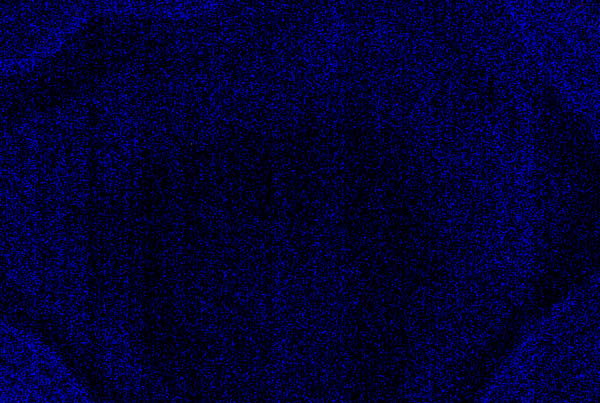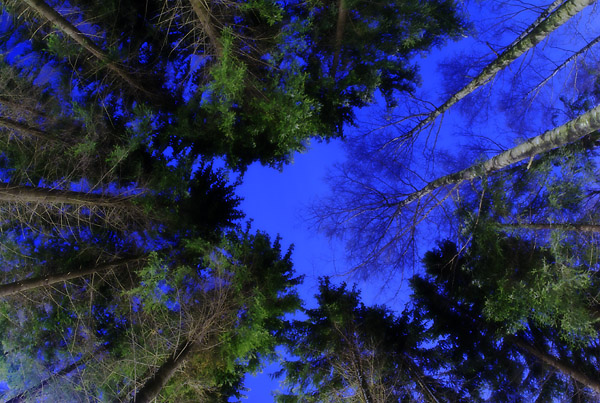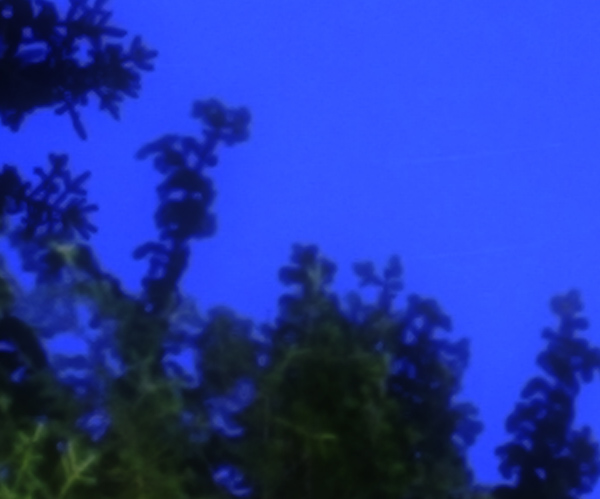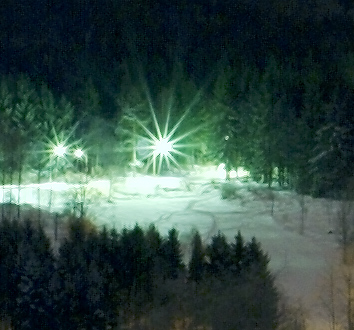| Nikon D200 Digital Camera
Reviewed |
|
|
| by Bjørn
Rørslett |
|
6.
Long Exposures
The last stand of film has
been the long-exposure domain, in which digital simply hasn't
been competitive. The arrival of Nikon D2H and D2X made a serious
dent in the film stronghold, and now D200 adds itself to the
growing rank of long-exposure candidates.
Nikon D200 has the ability to
create virtually noisefree, long-time exposures, and of very long
duration (if you can provide battery support for, or hook the
camera into an EH-6/6e AC/DC adapter). The camera tracks the
exposure time even on a "B" setting with high accuracy,
and it uses this information to run a second "blank"
exposure internally to cancel out noise accrued within the first
exposure. The second stage in case of the D200 does not last
exactly as long as the first, on an average about half the time,
and is only operative on exposures lasting more than approx. 8
seconds.
The D200, like
the D2H, uses a 16-bit counter to count time steps of a
"Bulb" exposure, and eventually this counter overflows.
Since the noise-reduction circuitry probably depends on knowing
the exact exposure time, this means the D200 would cease to do
effective NR after 109 minutes 13.5 seconds (= 65,535 steps each
of 1/10 sec duration). The EXIF data field is limited to 16 bits,
so you likewise won't get recorded the true duration of any
exposure beyond 6,553.5 seconds. Very unfortunately, this gives a
poor performance for really long exposures, say 3-5 hours.
You might object to the idea
of a camera spending up to half of a shooting session running its
noise-reduction program. However, since unlike film there is no
reciprocity error involved, the practical importance of the NR
delay is less significant than you might think. This simply means
that you will get twice the output for twice the exposure
duration, something film cannot match at all for long-time
exposures. In fact, reciprocity error will cut the effective
speed of a 100-125 ISO film to a level below that of the D200 for
any exposure longer than a few minutes. So, if you set a D200 and
a film-based camera side by side and tripped the shutters
simultaneously for a long exposure, you would finish first with
D200, even with its NR delay.
I could not find night skies
sufficiently dark for any exposure beyond a few minutes, so this
time I ran the long exposure tests with body cap on the camera.
Admittedly this is a less harsh test than exposing for dim
subjects, but you have to do whatever is feasible for a given
situation. I did this series of tests outdoors at ambient
temperatures ranging between -12° C and -2° C, mainly during
late evening or night. I feed the D200 from the AC mains to avoid
depleting the battery pack while testing.
The perfect test result should
be 100% perfectly black pixels, that is, with a zero value. This
occurred for exposures up to nearly 20 minutes, a tremendous
result indeed. However, because the data for the longer exposures
got lost with my server crash, I cannot show the graph. I did
recover the 4-hour exposure though, and it is shown below. The 4-hour
exposure was run in the deep of the night, so conditions should
be optimally stable for this test, but now noise increased
significantly since the internal time counter overflowed
(remember it's 16-bits only).
 |
| Black
as Black Can Get, or The Proverbial Black Cat in a Coal
Cellar? This is the
output from Nikon's D200, set @ 100 "ISO" with
long-term noise reduction on, after an exposure of 4 hours. The image looks perfect, but since the NR
hasn't been effective throughout the entire exposure time
(due to the overflow of the 16-bit counter, refer to the
text), there is in fact some noise buried deep within the
apparent darkness.

|
(Above) This is the
same image from a 4-hour exposure, brutally enhanced to show
the residual noise.
(Below) Another long-term exposure,
this is 73 minutes without NR on,
ambient temperature -7° C
Both examples indicate that the
self-induced (largely thermal) noise affects all four
sides of the CCD, quite unlike other Nikon DSLRs. We also
see that NR is very effective if you have turned it on.
My review camera hardly displayed any hot pixels at all,
even for this exposure lasting more than 1 hour (without
NR)
|
 |
| © Bjørn
Rørslett/NN |
Now, shooting black cats in coal cellars
might not be everyone's idea of the perfect picture, so I went
out in the middle of the night to get some more interesting
long-term exposures. One of these is shown below,

|
D200,
16 mm f/2.8 Fisheye-Nikkor f/8 @100 ISO equivalency, 901
sec. © Bjørn Rørslett/NN
This is a 15-minute night exposure
with the D200. No noise, no "hot" or
"dead" pixels, excellent colours; what more
could you ask for?

200% crop of the image above. Some
movement of branches of course (the night wasn't calm),
but otherwise absolutely nothing untoward to be seen.
Ambient temperature -12° C
|
Long exposures with street lights or
similar, strong point light inside the frame, indicated that the
D200 gracefully handled the overexposure bound to happen at these
highlights. In fact, the inevitable clipping of the highlights
seemed better and better controlled as exposure extended. I'll
have to do more research in this field, but there seems to be a
remarkable progress here compared to film (which will blow
out highlights and the glare from them will diffuse into the
surrounding shadows as well). See the example below to appreciate
this,

|
| A 100%
crop from the corner of a night shot. Notice the
film-like constrained flare rays from the point light
sources. Ambient temperature -12° C D200,58 mm f/1.2 Noct-Nikkor f/8 @100
ISO equivalency, 9 minutes © Bjørn Rørslett/NN
|
However, the price to be paid for all this
long-time wizardry is power, or rather battery, consumption. Lots
of it in fact. Thus at least under a sub-zero Norwegian winter
climate, 30- to 60-minute exposures seem to be an upper practical
limit because anything longer will completely drain even a fully-charged battery pack. I have tried so should know. Do remember the need
for conducting a noise-reduction stage afterwards. However, if
you can provide stable mains power (with the EH-6 unit), up to
109 minutes will work just fine. For longer exposures than the
109 minute limit you'll need to engage the D2X instead of the
D200, or go the proven silver-halide road. Film is still the
better solution for doing extremely long exposures, but we are
talking about a problem for only for a small minority of the
users here. Virtually all exposures taken with any camera are
shorter than 2-3 hours in duration.
Just for the fun of it, I investigated what
would happen if you intentionally let the camera deplete the
battery while doing a long exposure. I clamped down a MC-30
Remote Release with the camera set to "B" and just let
it run. After some 46 minutes, the camera gave in and terminated
the exposure, did not run any NR, and just wrote the image to the
CF card. This "break" obviously enabled the battery to
recalibrate, so the camera immediate commenced a new exposure,
this time lasting approx. 15 minutes before it again recorded the
file to the CF card. After that last attempt of getting a picture,
the camera just was dead. So, Nikon evidently gives highest
priority to the camera being able to transfer the image to the CF
card, and this does make sense. Better to have an image without NR than no image at
all.
Given the superb low-noise performance of
the D200, I wonder whether this is just a simple dark-frame
subtraction, or whether the D200 has more advanced and clever
tricks up its sleeve. Since the NR part of the exposure is just
about half as long as with the D2X, it's pretty obvious some new
wizardry is going on here. A pity though that Nikon skimped on
the internal counter to allow the return of the 16-bit limitation
of the D2H.





